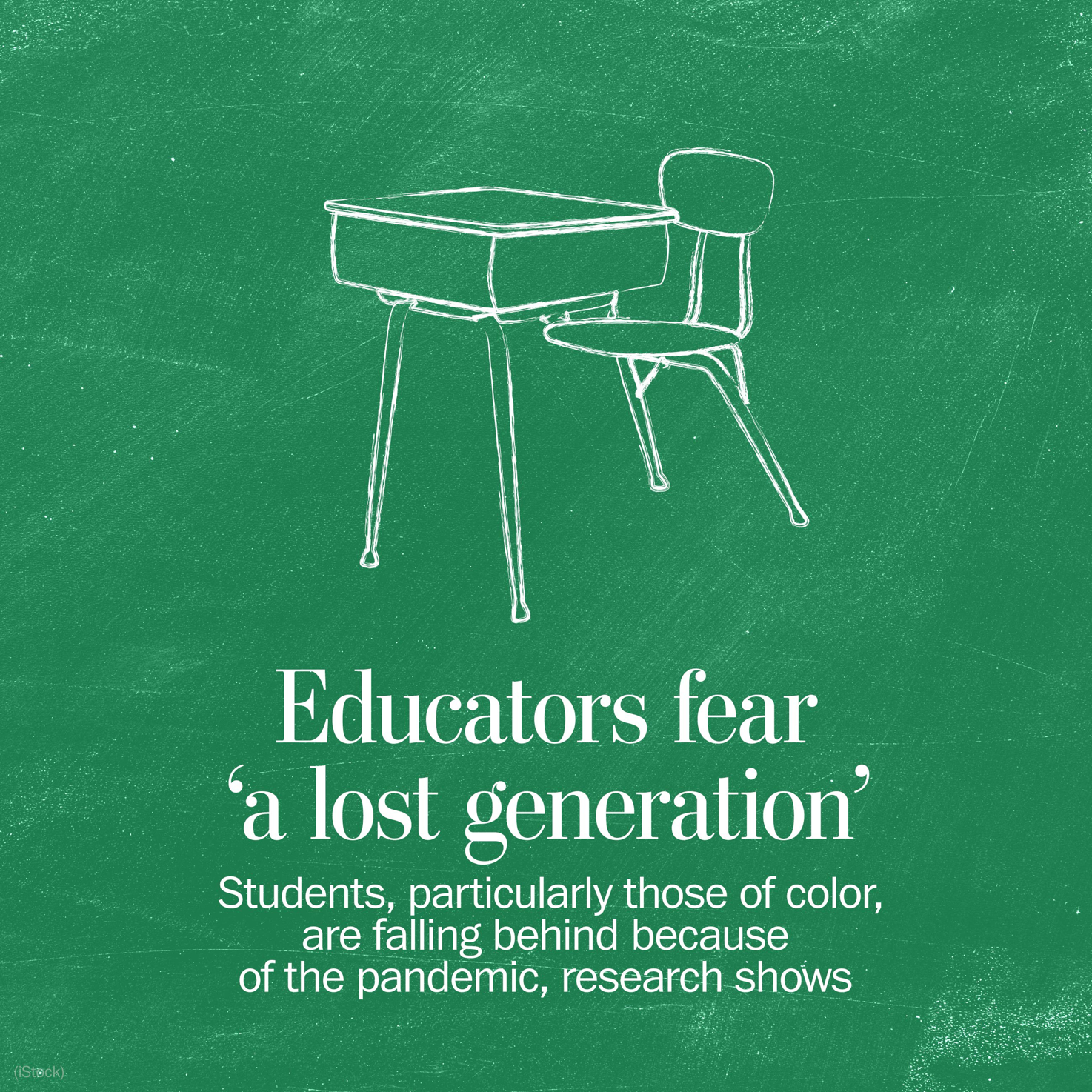After the U.S. education system fractured into Zoom screens last spring, experts feared millions of children would fall behind. Hard evidence now shows they were right.
A flood of new data — on the national, state and district levels — finds students began this academic year behind. Most of the research concludes students of color and those in high-poverty communities fell further behind their peers, exacerbating long-standing gaps in American education.
A study being released this week by McKinsey & Co. estimates that the shift to remote school in the spring set White students back by one to three months in math, while students of color lost three to five months. As the coronavirus pandemic persists through this academic year, McKinsey said, losses will escalate.
“I think we should be very concerned about the risk of a lost generation of students,” said former education secretary John B. King Jr., who is now president of Education Trust, an advocacy and research group focused on equity issues.
The McKinsey study echoes a half dozen other national reports released in recent days. They all find that students regressed because of lost classroom time in the spring, particularly in math, though the reports vary in degree of the losses and in disparities among student groups.
Separately, data released by multiple school districts show a sharp increase in failing grades this fall, particularly for the most vulnerable students.
And troubling data is emerging about college application rates. Applications for federal student aid were down 16 percent this fall, as were submissions to the Common Application, a portal used by hundreds of colleges. The drop there was larger from Hispanic and low-income students and those whose parents did not attend college.
“We were expecting great challenges, but when you see it happening it is heartbreaking,” said Jenny Rickard, Common App’s president and chief executive.
Experts have been predicting learning losses since it became clear that the pandemic would shutter schools for an extended period. Some predictions were overblown, and some recent studies find the lost learning has been moderate rather than severe. But in general, the concerns appear to have been warranted, with greater losses expected as the school year progresses.
Together, the new research raises important questions about how American children can recover once the pandemic is over, and how educators can try to mitigate the gaps until then. Experts say high-intensity tutoring and summer school programs both have track records of success, but those would cost tens of billions of dollars to reach all students who will need remediation at a time when school districts are already struggling to pay for basic needs.
“Something out of the ordinary is needed to help these kids catch up,” said Emma Dorn, one of the authors of the McKinsey report. “No matter what we do now, tangible learning loss has already occurred.”
Some say the answer is to get more children back to in-person school. Limited data suggests open schools have not been a significant source of contagion, but the high coronavirus infection rates across the country have halted plans for a return in some districts and hardened fears of going back among many teachers and parents.
“We should have the vast majority of elementary school students back in school. It’s just not that dangerous,” said Nat Malkus, a resident scholar in education policy at the American Enterprise Institute, a right-leaning think tank. “We are still bleeding, so the first thing is to stop the bleeding, and then we’re going to have some healing to do, and it’s going to take years.”
Moving backward
The assessments this fall measure the results of last spring’s sudden shift to online learning, which was widely considered a disaster — leaving students unable to connect and teachers unprepared to do their jobs remotely.
Although the fall version of remote education appears improved, and some students are back in school buildings, millions of children are still learning from home. This setup privileges children who have quiet places to work, parents at home to help and reliable Internet service. Many of those who don’t have those advantages continue to struggle, and even some families with resources find it difficult to keep children engaged online and emotionally healthy.
In some cases, districts report that students are not even showing up for remote classes, making it virtually certain they will fall behind.
Black and Hispanic students are less likely to have computers and Internet access, though wide gaps seen in the spring on this point have narrowed. In the spring, 79 percent of Black students had a device for school; by the fall, that reached 89 percent. But that was still short of the nearly 93 percent of White students who had devices in the fall, the census found.
Malkus’s research finds that children in high-poverty districts missed an average of about 12 days of classroom time during remote learning in the spring — compared to eight days at low-poverty schools — because they were not participating in classes, in some cases because they could not digitally connect.
In Connecticut, attendance among Black, Latino and “high-needs” students — meaning those with disabilities, children from low-income families and English-language learners — is down by roughly 5 percent this year, the state reported. The declines are worse in districts located in some of Connecticut’s poorest cities.
Chicago Public Schools reported enrollment among Black pre-kindergartners had dropped by 44 percent, and by nearly 30 percent for Latino children, both larger figures than those for White and Asian children.
Going forward, McKinsey estimates that academic losses will be greatest for Black and Hispanic students, partly because they are less likely to be attending school in-person than White students are. The firm also points to polling by the Census Bureau that found 15 percent of Black students and 16 percent of Hispanic students had no live access to teachers, compared to 8 percent of White students.
A high school teacher in Avon, Ind., said he still has trouble getting in touch with up to a quarter of his more than 100 students. At least five children are a full two months behind their peers, he estimates, and 15 percent are a week or two weeks behind where they should be. And when he surveyed his students last week, 75 percent reported feeling as though they were slipping behind in one or more classes.
The students trailing academically are predominantly from low-income families, said the teacher, who spoke on the condition of anonymity because his district forbids teachers from speaking to the press. He pointed to a student who, two weeks ago, informed him that their family’s financial situation required that they begin providing child care for younger siblings. The student loved his class, they said, but couldn’t find time to attend anymore.
After seeking guidance from higher-ups, the teacher sent the student all the course materials. He is hoping the child will work away at them in free moments.
A flood of evidence
The evidence of learning losses comes from two primary sources. There is national data on back-to-school test results, such as the McKinsey analysis, which measure how much regression took place in the spring by comparing results to prior years.
The second source is school districts themselves, which have reported spikes in the number of failing grades given by teachers this fall, evidence that the learning losses are continuing. The sharpest increases have been for Black and Latino students, those in low-income families, students with disabilities and those learning English.
In Maryland, the Montgomery County Public Schools reported that more than 36 percent of ninth-graders from low-income families failed English this fall, up from 6 percent last year.
California’s Sweetwater Union High School District, near San Diego, said nearly half of all grades given to English-language learners this fall were D’s and F’s, up from 34 percent last year.
The most popular and interesting stories of the day to keep you in the know. In your inbox, every day.
In southern Illinois, the Carbondale Elementary School District reported that 30 percent of Hispanic students failed at least one class, up from 16 percent last year. Among White students, the figure barely changed, going from 15 percent to 16 percent.
And Virginia’s largest school district, Fairfax County Public Schools, reported that 19 percent of students with disabilities had at least two failing grades, up from 9 percent last year.
Kari Chambers of Prince William County, Va., sees the regression happening with her 9-year-old son, who has a reading disability. He struggles to make his way through a paragraph, blinking in pain and confusion. He gets help from his regular classroom teacher, a special-education teacher and his mom, who guides him through his assignments. Nonetheless, Chambers said, he is falling behind.
Her son has begun to write his letters backward again. Pre-pandemic, he could sound out a sentence and copy it down in a mostly legible script. Now, she can only occasionally pick out a recognizable word in his scrawl.
“Until we shut down last year, he was headed on a really good path,” she said. “He’s definitely regressed a lot, which is really sad.”
The national research finds math losses are greater than reading losses.
Experts suggest that may be because math concepts are different each year — learning to multiply is different from learning fractions — whereas reading involves similar skills that deepen as students grow.
“Math is a very cumulative subject. They are building blocks that build on top of each other,” said Katie McClarty, vice president for research at Renaissance Learning, which provides online testing nationwide. “As long as students continue to read books, they are going to continue to progress.”
In addition, she said, it’s possible that parents are better equipped to help with reading than with math.
In a recent report, Renaissance found it would take students in fifth and sixth grades 12 or more weeks of additional instruction in math to reach beginning-of-year expectations. Students in other grades would need somewhat less.
For reading, Renaissance estimated children in fourth through seventh grades would need four to seven weeks to catch up. It found a similar reading gap when it examined students at high-poverty schools participating in the federal Title I program.
Students in other grades and at wealthier schools, though, were meeting or even slightly exceeding reading expectations.
The most optimistic recent research comes from NWEA, a nonprofit testing organization. It found students in math were five to 10 percentile points lower than same-grade students last year, with little change in reading results. But researchers there cautioned that a large share of students who normally take the test were missing, and said the missing students were those most at risk.
“We are likely underestimating the impact of those who are most marginalized,” said Beth Tarasawa, executive vice president for research and a co-author of the NWEA report.
Gaps were also evident in data from a widely used online math program called Zearn, and in an analysis by Curriculum Associates, creator of the i-Ready assessment program.
The McKinsey report also is based on data from the i-Ready assessments in 25 states. It compared results from this fall to the scores of similar students from recent years and then estimated how much school time would be needed to bring this year’s students to those levels.
McKinsey only looked at tests administered in school buildings to allow for apple-to-apples comparisons to past years. It found students tested at home did better than those in buildings, and while the reasons are not entirely clear, researchers think it is possible that parents were helping. In any case, the tests were administered at the start of the year, so the results were affected by what happened in the spring, when virtually all students were learning remotely.
McKinsey projected that students will continue to fall behind this year.
If the status quo remains through June, McKinsey predicts White students will lose seven to eight months of math, and students of color will lose 11 to 12 months. The difference, Dorn said, is that students of color are less likely to be in school and less likely to have live instruction.
Its best-case scenario holds that the system stays as is until January and then typical growth resumes, which presumes schools are able to reopen. In that case, it predicts the average White student will have lost four to five months in math and the average student of color will have lost six to seven months.
“Even if everyone was back to school on January 1, we’re still dealing with five months of lost learning in math,” Dorn said. “We’re still going to need something more dramatic.”
Looking for answers
This data has experts considering ideas big and small for making up ground.
Scaling up high-intensity tutoring to cover half of all U.S. students would cost $66 billion, at $2,500 per student, McKinsey estimates. It estimates it would cost $42 billion, or $1,600 per student, for “vacation academies” over summer break to serve small groups.
Another big idea being promoted in Washington is to ensure that states protect the neediest school districts from spending cuts if they receive federal aid from a coronavirus package.
Some smaller programs are underway, though.
Education Resource Strategies, a Watertown, Mass.-based nonprofit, recommends that teachers set aside one day each week to contact students they are most worried about. The group also recommends working with community organizations to provide tutoring and other support.
Over the summer, a Milwaukee elementary school held an online tutoring program, pairing teachers and college students, many of them Black, with about 30 mostly Black children for up to four hours of one-on-one video instruction each weekday.
Melinda Gladney, principal of Ralph H. Metcalfe Elementary School, said that testing showed participants made, on average, 2½ months’ worth of progress in one summer month. Teachers report that participants were better prepared for school this fall than their peers. And, she said, the children loved being part of it. “They lit up being able to have that connection,” she said.
Another idea is to tighten focus to foundational, core skills and leave out other enriching but not essential material. McClarty, from Renaissance, says the ability to multiply numbers is a core or “focus” skill because multiplication facts are used as students progress. But she said rounding numbers is not because other skills do not build on that.
Janice Pavelonis, director of curriculum and instruction in Carbondale, said her district worked to focus the curriculum on core skills to keep students advancing.
Officials also work to find missing kids by tracking attendance and sending staff members to their homes, delivering supplies and touching base.
Pavelonis also already has set aside money for summer programs for students who have fallen behind. She plans to prioritize students who were already behind and then fell further during the pandemic, she said. Other children, she suspects, will bounce back more quickly.
Karen Hawley Miles, chief executive of Education Resource Strategies, suggests schools rethink the school day, increase social and emotional supports for pandemic-traumatized children, and figure out a way to send the highest-quality, highest-paid teachers to serve the neediest students.
It will be an uphill climb, she cautions. “Schools weren’t serving these students to begin with.”




